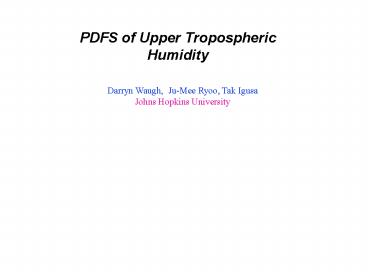PDFS of Upper Tropospheric Humidity
1 / 13
Title: PDFS of Upper Tropospheric Humidity
1
PDFS of Upper Tropospheric Humidity
Darryn Waugh, Ju-Mee Ryoo, Tak Igusa Johns
Hopkins University
2
Introduction
- Climate is sensitive to upper tropospheric
humidity, and it is important to know - the distributions of water vapor in this region,
and - the processes that determine these
distributions. - We examine the probability distribution functions
(PDFs) of upper tropospheric relative humidity
(RH) for measurements from - Aura MLS
- Aqua AIRS
- UARS MLS
- Consider spatial variations of PDFs. Focus here
on DJF, 215hPa - Also compare with theoretical distributions
(generalization of Sherwood et al (2006) model).
3
Climatological UT Relative Humidity
DJF 200-250hPa Relative Humidity (AIRS)
- Subtropics is drier than the Tropics
- But also significant zonal variations
4
PDFs AIRS
200-250hPa
Large variation in PDFs - spread, skewness,
40E-60E
260E-280E
120E-140E
Subtropics (15-25N)
similar
Different shape
Tropics (5S-5N)
5
PDFS AIRS - Aura MLS Comparison
260E-280E
40E-60E
120E-140E
Subtropics (15-25N)
Tropics (5S-5N)
Good agreement between AIRS and Aura MLS, with
some exceptions.
6
Theoretical Model Sherwood et al (2006)
Sherwood et al (J. Clim, 2006) showed that PDFs
of Relative Humidity (R) in simple
advection-condensation model are of the form
where r ???dry ???moist , ?dry is drying
time due to subsidence Rexp(-t/?dry),
?moist is time scale of random remoistening
events P(t) exp(-t/?moist) /
?moist , .
Larger r implies more rapid remoistening
7
Theoretical Model Generalized Version
Generalized version of Sherwood et al model
where time since last saturation is now modeled as
k is measure of randomness of remoistening
events. k1 is original Sherwood et al. model.
- Larger r implies more rapid remoistening
- Larger k implies less random remoistening
processes.
8
PDFs Data and Model
How well do the theoretical models fit the
observed PDFs?
260E-280E
40E-60E
120E-140E
Subtropics (15-25N)
kgt1
k1 (Sherwood)
Tropics (5S-5N)
Model can fit the observed PDFs, with r and k
varying with location.
9
Spatial Variations in r
r ?dry / ?moist
Subtropics (15-25N)
Good agreement between different data sets. All
show rgt1in tropical convective regions, and
rlt1 in dry regions. Expected as larger r
implies more rapid remoistening
Tropics (5S-5N)
10
Maps of r and k
r
mean RH
k
- Convective Regions
- rgt1 and low k
- Rapid, random remoistening
- Non-convective Regions
- rlt1 and high k
- Slower, more regular remoistening (horizontal
transport)
11
Aura MLS - AIRS bias
AIRS MLS
There are some differences between MLS and AIRS
PDFs. Differences are not simply a function of
RH. Is there a simple mapping between MLS and
AIRS?
12
Aura MLS - AIRS bias
AIRS MLS
RMLS/RAIRS
300
RMLSgt RAIRS
Transform MLS Data
RMLS/RAIRS f(RMLS,OLR)
NOAA OLR
2.0
1.5
1
.8
.4
150
200
100
0
RMLS
13
Conclusions
- Several robust features are found in the observed
PDFs from all three data-sets (Aura and UAR MLS,
AIRS) - Well fit by a generalized version of the
Sherwood et al. (2006) theoretical model. - Consistent spatial variations in r (ratio of
drying and moistening times) and k (randomness
of moistening process). - Variations in r and k can be related to
variations in the physical processes controlling
the RH distributions. - Differences between MLS and AIRS do exist. There
is a rather simple mapping, which depends on OLR
and RH, to account for bias between MLS and AIRS.































